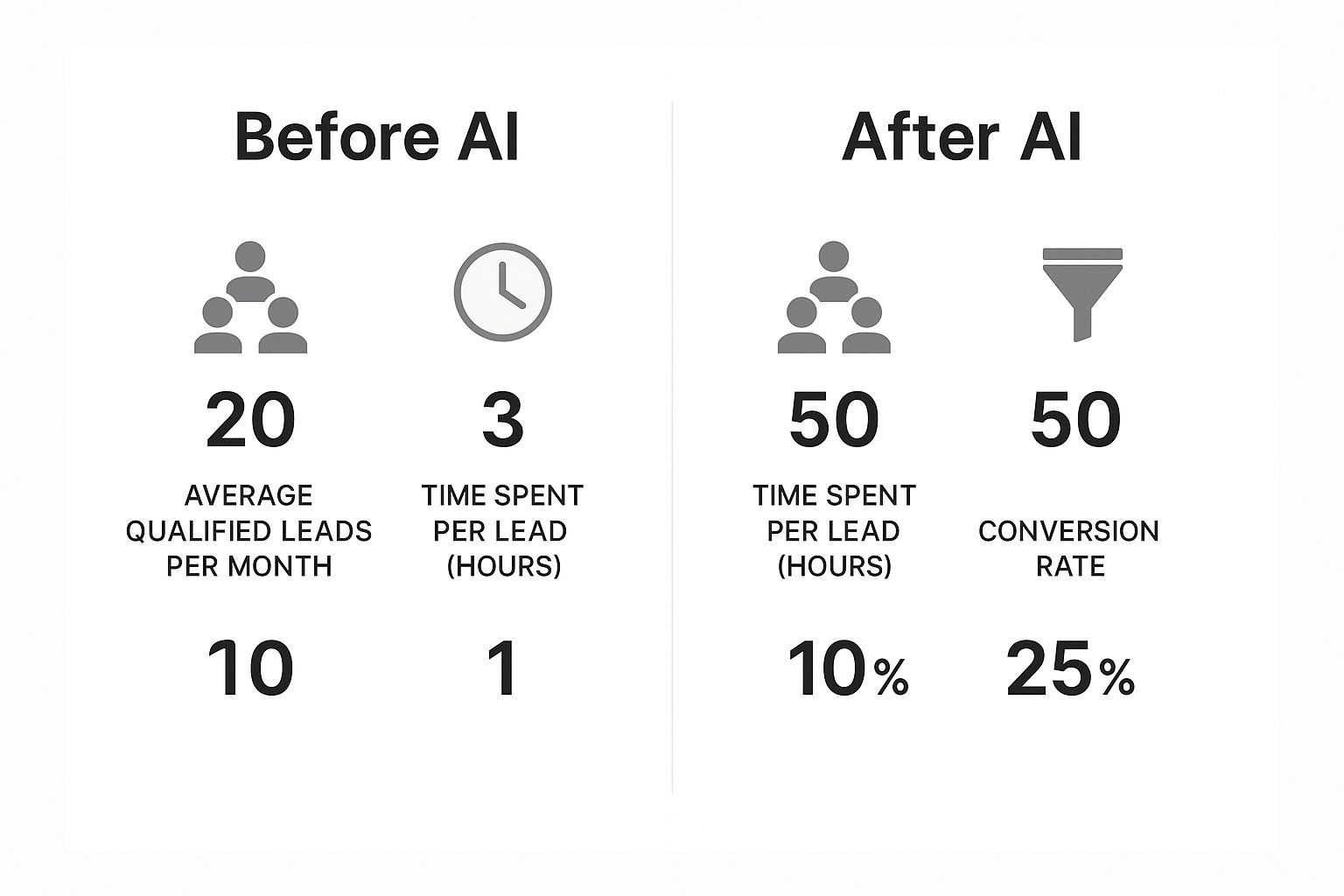Ai Powered Lead Generation Strategies to Boost Sales
Let's cut through the jargon. At its heart, AI-powered lead generation is about using smart technology to find, qualify, and connect with potential customers far more effectively than any manual process ever could. It’s a shift away from a "spray and pray" mindset.
Instead of your team spending hours sifting through endless lists, AI does the heavy lifting. It analyzes massive amounts of data to pinpoint who is most likely to buy, and can even start the conversation before a salesperson ever gets involved.
What Is AI-Powered Lead Generation, Really?

Think about it like this: traditional lead generation is like using a giant fishing net. You catch some of what you want, but you also haul in a lot of junk you have to sort through later. An AI-powered approach is more like having a sophisticated sonar system that only pings the exact fish you're after.
It's not just about speed; it's about being smarter. The real magic of AI here is its ability to predict outcomes and personalize interactions. It looks at everything from a prospect's website clicks to their social media comments, finding subtle patterns that a person would miss.
Moving Beyond Manual Work
For years, getting new leads was a grind. Sales and marketing teams cast a wide, often inefficient net through cold calls, mass emails, and other time-consuming tasks. It was a numbers game, and frankly, the returns were often pretty low for the effort involved.
AI completely flips that script. It brings in intelligent systems that handle the tedious, top-of-funnel work, which frees up your team to focus on what they do best: talking to genuinely interested people. It’s a deliberate move from chasing quantity to connecting with quality.
Here’s where you really see the difference:
- Data Analysis: An AI can analyze millions of data points in the time it takes you to drink your coffee. It builds an incredibly detailed ideal customer profile that would be impossible for a human team to assemble.
- Predictive Scoring: Forget guesswork. AI scores leads based on their actual likelihood to convert, pointing your team directly to the hottest prospects in the pipeline.
- Personalized Outreach: Imagine sending thousands of unique, personalized messages that feel one-on-one. AI tools can do that, making every single prospect feel seen and understood.
By taking over the repetitive, top-of-funnel activities, AI lets your best people focus on building relationships and closing deals. Your sales process stops being reactive and becomes a proactive, data-driven machine.
Ultimately, integrating AI powered lead generation isn't just a fancy upgrade; it's becoming a strategic necessity. It gives your team the insight to work more efficiently, understand your customers on a much deeper level, and build a real competitive advantage.
How AI Is Redefining the Lead Generation Playbook
To really get what makes AI-powered lead generation tick, we need to pop the hood and see how the engine actually works. It’s not some single magic button; it's a suite of intelligent systems working in concert to find your next best customer with uncanny accuracy.
At its heart is machine learning (ML), the component that learns from your data. Think of it like this: you feed the AI every scrap of information you have on your best customers—their industry, company size, the job titles of your main contacts, and how they've interacted with you in the past. The ML algorithm then churns through that data mountain to build an Ideal Customer Profile (ICP) that is constantly learning and evolving.
This isn’t a static persona document collecting dust on a shared drive. It’s a living, breathing profile that gets sharper with every new lead and every closed deal. This lets the AI spot subtle patterns and traits of a perfect-fit customer that a human team might easily miss.
Predictive Scoring for Smarter Prioritization
Once the AI has a solid grasp of who it's looking for, it can get to work evaluating new prospects as they come in. This is where predictive lead scoring shines. Instead of salespeople relying on gut feelings or simple demographic checkboxes, the AI assigns a score to each new lead based on how well they match that data-driven ICP.
It looks at their real-time behavior, too, factoring in everything from the specific pages they browse on your website to the content they engage with. A prospect who downloads your pricing guide is instantly scored higher than someone who just glanced at a single blog post.
This smart ranking system means your sales team can stop wasting time on lukewarm leads. They get to focus their energy entirely on prospects who are statistically most likely to convert, which massively boosts their efficiency and win rates. This change is critical, especially when you learn that by 2025, a full 50% of marketers worldwide will rank lead generation as their top priority, fueled by exactly these kinds of data-centric strategies. You can explore more of these marketing trends to see just how quickly the industry is moving.
Natural Language Processing for Human-Like Conversations
The final piece of the puzzle is communication. Natural Language Processing (NLP) is the technology that gives tools like chatbots and email automation platforms the ability to understand, interpret, and generate text that sounds genuinely human.
Thanks to NLP, a chatbot can do much more than spit out canned answers. It can understand a visitor’s specific problems, qualify them as a lead based on their conversation, and even book a meeting directly on a sales rep's calendar—all without a human lifting a finger. In the same way, NLP is behind email campaigns that can personalize outreach at a massive scale, finally moving us beyond the tired, ineffective methods of the past. If you're curious, you can dig deeper into why cold outreach doesn't work anymore right here.
To see the difference in black and white, let's compare the old way with the new.
Traditional Vs AI Powered Lead Generation Methods
| Task | Traditional Method | AI-Powered Method |
|---|---|---|
| Finding Leads | Manually searching LinkedIn, buying static lists, attending events. | AI automatically identifies and surfaces prospects based on a dynamic ICP. |
| Qualifying Leads | Sales reps spend hours on discovery calls with often unqualified prospects. | Predictive scoring automatically ranks leads based on their likelihood to convert. |
| Personalization | Generic email templates with basic "first name" token replacements. | NLP generates hyper-personalized messages based on individual behavior and data. |
| Engagement | Human-only interactions, limited to business hours. | 24/7 engagement through intelligent chatbots that qualify and book meetings. |
| Team Focus | High-volume, low-quality manual tasks. A numbers game. | High-value, strategic conversations with the most promising leads. |
The evolution is clear. AI isn't just about doing the same old tasks faster; it’s about fundamentally changing the quality and focus of the entire lead generation process.
The infographic below paints a vivid picture, showing the dramatic shift in key metrics when you move from manual drudgery to an intelligent, AI-driven approach.

The numbers speak for themselves. AI directly improves lead quality, frees up countless hours for your team, and gives your conversion rates a serious boost.
The Real Business Impact of Using AI for Leads

Bringing AI powered lead generation into your workflow does more than just top up your sales pipeline. It can seriously reshape the financial health and overall muscle of your entire sales operation. The first thing you'll notice is a huge leap in lead quality. AI isn't about finding more leads; it's about finding the right ones.
By homing in on prospects who are a perfect fit for your ideal customer profile and are already showing signs they're ready to buy, your sales team stops chasing dead ends. This laser-like focus naturally leads to shorter sales cycles because you're talking to well-informed, problem-aware buyers from the very first hello.
Driving Down Costs and Scaling Up Growth
This newfound efficiency has a ripple effect right down to your bottom line. When your team starts converting a higher percentage of the leads they work, your customer acquisition cost (CAC) inevitably drops. Suddenly, every marketing and sales dollar stretches further, freeing up budget you can pump back into other growth initiatives.
And the data doesn't lie. Companies using AI for lead generation report a more than 50% jump in sales-ready leads. At the same time, they're often slashing their lead generation costs by as much as 60%. The results are pretty staggering when you see them in action.
On top of that, AI brings a level of scalability to the table that a human team just can't replicate. Picture an AI chatbot on your website. It can juggle thousands of conversations at once—qualifying visitors, answering common questions, and booking demos 24/7, even while your team is asleep.
Think of AI as a force multiplier. It takes over the high-volume, repetitive grunt work, freeing up your sales experts to do what they do best: build relationships and close complex deals that need a human touch.
Enhancing Customer Understanding
But it's not all about the hard numbers. AI also gives you a much richer, deeper understanding of your target market. By analyzing conversations and behaviors across the web, these systems can spot customer pain points, buying signals, and new trends you might otherwise miss. This kind of intel is gold for keeping your strategy sharp and ahead of the curve.
For instance, an AI tool could be scanning social media right now and flag a post where someone complains about a competitor's product flaw, or another where a user asks for a solution you happen to offer. This is the heart of effective social media reputation monitoring, turning passive listening into active sales opportunities.
This all leads to a much more agile and proactive sales process. Your team can reach out with messages that are incredibly relevant and timely, speaking directly to a prospect's immediate needs. It’s the difference between a cold call out of the blue and jumping into a conversation that’s already happening.
At the end of the day, AI powered lead generation isn't just another tool. It's a strategic engine for building sustainable, cost-effective growth.
Your Step-by-Step Guide to AI Implementation

Jumping into AI-powered lead generation can feel like a massive undertaking, but breaking it down into manageable steps makes it far less intimidating. The trick is to start small, prove the concept's value, and then build on what works.
This isn't about trying to boil the ocean. It's about laying a solid foundation, one brick at a time. The following five-step framework will walk you through everything from initial planning to full-scale adoption, ensuring your investment pays off.
Step 1: Define Your Goals
First things first: what are you actually trying to accomplish? Before you even glance at a single AI tool, you need crystal-clear objectives.
Are you trying to boost the sheer number of qualified leads? Maybe your goal is to shorten the sales cycle or cut down the time your reps spend prospecting. Your specific goals will be the compass that guides your entire strategy.
Don't be vague. "Get more leads" isn't a goal; it's a wish. A real goal sounds more like, "increase Marketing Qualified Leads (MQLs) by 20% within the next quarter." Clear, measurable targets are non-negotiable.
Step 2: Assess Your Current Setup
Let’s be honest: AI is only as good as the data it's fed. If your data is a mess, your results will be, too. It’s time for a frank assessment of your current CRM and marketing automation platforms. Is your customer data clean, organized, and reasonably up-to-date?
This is also the moment to map out your existing tech stack. You have to understand how a new AI tool will slot into your current workflow. The last thing you want is another siloed piece of software that just creates more work for everyone.
A huge part of this step is identifying your biggest bottlenecks. Is your team drowning in junk leads? Or are they struggling just to find good prospects? The answer will point you directly to the kind of AI solution you need most.
Step 3: Select the Right AI Tools
With your goals set and your current state understood, you can finally start shopping for tools. The market is crowded, but most solutions fall into a few main categories, each built to solve a different problem.
- Conversational AI: Think chatbots that engage website visitors, answer common questions, and qualify leads on the spot.
- Predictive Analytics: These platforms analyze your data to score leads based on their likelihood to buy, helping your team focus on the hottest prospects.
- Buyer Intent Platforms: These tools act like a radar, monitoring online signals to find companies that are actively researching solutions just like yours.
Step 4: Launch a Pilot Project
Whatever you do, don't try to roll out a brand-new AI system to your entire company at once. That's a recipe for disaster.
Instead, start with a small, controlled pilot project. Pick a small team or a specific marketing campaign to test the new tool. This approach minimizes risk and lets you learn fast. You can iron out the kinks, gather real performance data, and build a powerful case for a wider rollout. The insights from a successful pilot are your best ammunition for getting leadership buy-in.
Step 5: Scale and Train Your Team
Once your pilot project has delivered clear results, you’re ready to scale up. This is about more than just giving everyone a login. Proper training is absolutely essential. You need to make sure your team understands how to use the new tools and, just as importantly, trusts the information they're getting.
This is the step that turns AI-powered lead generation from a side experiment into a core part of your growth engine. For a deeper dive into the fundamentals that underpin this entire process, our beginner's guide to B2B lead generation is a great place to start.
Top AI Lead Generation Tools and Platforms
Trying to find the right AI tool for lead generation can feel like drinking from a firehose. There are a ton of platforms out there, all promising the world. The best way to cut through the noise is to think about what you're actually trying to accomplish.
Instead of just giving you a long, boring list, let's break these tools down by what they do. We'll look at three main categories and spotlight a top player in each. This way, you can match a specific tool to the biggest headache you're facing right now.
Conversational AI for Real-Time Engagement
Imagine being able to talk to every single person who lands on your website, right when they're most interested. That's the promise of conversational AI. These tools—usually smart chatbots—engage visitors 24/7, answering questions, figuring out if they're a good fit, and even booking meetings on the spot.
They use something called Natural Language Processing (NLP), which is just a fancy way of saying they can understand what people type and respond in a surprisingly human way.
A great example here is Drift. It's not just a passive chat bubble sitting in the corner. Drift actively:
- Starts conversations with your most important visitors, based on who they are or what they’re clicking on.
- Asks qualifying questions during the chat, so your sales team only spends time with people who are actually ready to talk.
- Connects straight to your team's calendars to book meetings instantly, cutting out the annoying back-and-forth emails that kill deals.
Predictive Scoring for Prioritizing a Crowded Pipeline
If your team is drowning in leads and has no idea which ones to call first, predictive scoring tools are your new best friend. These platforms dig into your past sales data to figure out what your perfect customer looks like. Then, they score every new lead based on how well they fit that ideal profile and how engaged they are.
Think of it as an intelligent filter for your pipeline. Instead of your sales team working leads alphabetically, they can focus their energy exclusively on the prospects with the highest statistical probability of closing, boosting efficiency and morale.
6sense is a major player in this area. It's fantastic at uncovering which accounts are genuinely "in-market" to buy right now. It ranks your target accounts and even tells you what topics they're researching, giving your team the intel they need for a perfectly timed, super-relevant outreach.
Buyer Intent Platforms for Perfect Timing
This is where things get really powerful. Buyer intent platforms are all about finding people who are actively looking for a solution right now. These tools scour the web—from forums and social media to review sites—to catch the digital breadcrumbs people leave when they're getting ready to make a purchase.
This is exactly where a tool like Intently comes in. Think of it as your team of digital scouts, constantly listening for buying signals on platforms like Reddit, X (formerly Twitter), and LinkedIn.
For instance, Intently can spot when someone posts a question about a problem your product solves or asks for recommendations for a tool in your category. By flagging these conversations the moment they happen, it lets your team jump in with helpful advice, starting a relationship long before your competitors even know an opportunity exists.
Common AI Implementation Mistakes to Avoid
Jumping into AI-powered lead generation is exciting, but it’s easy to trip over some common hurdles right out of the gate. The biggest one? Forgetting the age-old data rule: garbage in, garbage out.
An AI is only as good as the data you feed it. If your CRM is a mess of incomplete profiles, old contact info, or just plain wrong data, your AI will learn all the wrong things and spit out terrible leads. Before you even think about flipping the switch on a new tool, you have to get your data house in order.
Setting Unrealistic Expectations
Another classic mistake is expecting AI to be some kind of magic wand that instantly solves all your lead gen problems. It’s a powerful tool, sure, but it's not a miracle worker. It needs time to learn the ropes—your business, your ideal customers, and the nuances of your market.
If you go in expecting perfect leads on day one, you're setting yourself up for disappointment and might be tempted to pull the plug too early. A better way to think about it is like onboarding a new, incredibly fast employee. There's a learning curve while the system ramps up and your team figures out how to work with it.
Don't aim for a "set it and forget it" system from the start. Think of AI as a powerful assistant that takes the tedious work off your team's plate, freeing them up to focus on strategy and building real human connections.
Forgetting the Human Element
Perhaps the most critical error is trying to automate the human touch right out of the process. The most successful AI-powered lead generation strategies are the ones that blend machine efficiency with human oversight and intuition.
Your sales team's gut feelings and experience are irreplaceable. They can pick up on subtle cues in a conversation that an AI might completely miss or add that personal story that seals the deal. Plus, with everyone (rightfully) concerned about data privacy, having a human in the loop is non-negotiable for making sure you’re using customer data ethically.
Steering clear of these common pitfalls will make your transition to AI much smoother. The goal isn't a total machine takeover; it's a smart partnership between human expertise and AI efficiency.
Your Top AI Lead Generation Questions, Answered
Jumping into AI for lead generation is exciting, but it's natural to have a few practical questions. Let's walk through some of the most common ones that come up.
Will AI Replace My Sales Team?
This is probably the number one question on everyone's mind, and the answer is a firm no. Think of AI as the ultimate sales assistant, not a replacement.
AI is brilliant at handling the grunt work—the tedious, repetitive tasks that eat up your team's day. It can sift through mountains of data, score leads in seconds, and handle initial qualification chats. This frees up your human sales experts to do what they do best: build genuine relationships, navigate complex negotiations, and close big deals.
It's all about creating a powerful partnership. AI brings the efficiency, and your team brings the irreplaceable human touch.
How Much Does It Cost to Get Started?
The cost can vary quite a bit, but getting started is probably more affordable than you think. You don't have to overhaul your entire operation overnight.
Simple tools, like an AI-powered chatbot for your website, can cost less than $100 a month. More sophisticated platforms that offer predictive scoring or track buyer intent signals will, of course, come with a higher price tag.
The trick is to start small. Pinpoint your single biggest bottleneck—maybe it's lead qualification or finding new prospects—and find a tool that solves that specific problem. Prove the ROI on a smaller scale, and then you can justify a larger investment down the line.
How Do I Measure the ROI on AI Tools?
You absolutely have to measure the return on your investment. Without tracking the right numbers, it's just a shiny new toy. The key is to connect the tool's performance to real business outcomes.
Here are a few core metrics you should be watching:
- Better Lead Quality: What percentage of your marketing leads (MQLs) are now converting into sales-ready leads (SQLs)? This number should go up.
- Faster Sales Cycles: Are your deals closing faster? Track the time from the first touchpoint to the final signature.
- Lower Customer Acquisition Cost (CAC): How much are you spending to bring in each new customer? AI's efficiency should help drive this cost down.
By keeping a close eye on these KPIs, you can draw a straight line from your investment in AI to tangible growth for your business.
Ready to stop searching for leads and start engaging with buyers who are actively looking for you? Intently’s AI-powered platform scours platforms like Reddit and X to find high-intent conversations, delivering real-time opportunities directly to your inbox. Discover your next best customer at https://intently.ai.
